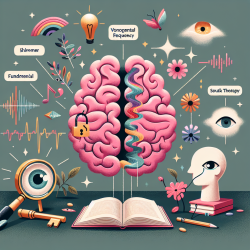As a speech therapist, understanding the intricacies of phonological disorders can significantly enhance your practice. The recent study, "Analysis of fundamental frequency, jitter, shimmer and vocal intensity in children with phonological disorders," provides valuable insights that can be applied to improve diagnostic and therapeutic approaches. Let's dive into the key findings and practical applications of this research.
Key Findings
The study focused on analyzing fundamental frequency (F0), jitter, shimmer, and vocal intensity in children with phonological disorders compared to a control group. Here are the main results:
- Fundamental Frequency (F0): The F0 of vowel /e/ was significantly lower in the phonological disorder group (126 Hz) compared to the control group (237 Hz).
- Jitter and Shimmer: No significant differences were found between the groups for jitter and shimmer, indicating similar vocal fold vibration control.
- Vocal Intensity: Children with phonological disorders exhibited lower vocal intensity for vowels /a/, /e/, and /i/ compared to the control group.
Practical Applications
These findings offer several practical applications for speech therapists:
- Targeted Assessments: Incorporate the measurement of F0, jitter, shimmer, and vocal intensity into your assessments to gain a comprehensive understanding of a child's vocal characteristics.
- Personalized Interventions: Use the data on vocal intensity and F0 to tailor interventions that address specific weaknesses in vocal production, such as increasing vocal intensity through exercises that enhance subglottic pressure and glottic resistance.
- Early Detection: The significant difference in F0 for vowel /e/ can serve as an early indicator of phonological disorders, allowing for earlier intervention and potentially better outcomes.
Encouraging Further Research
While this study provides a solid foundation, further research is essential to explore the relationship between vocal parameters and phonological disorders. Investigating larger sample sizes and diverse populations can help validate these findings and uncover additional nuances.
To read the original research paper, please follow this link: Analysis of fundamental frequency, jitter, shimmer and vocal intensity in children with phonological disorders.










